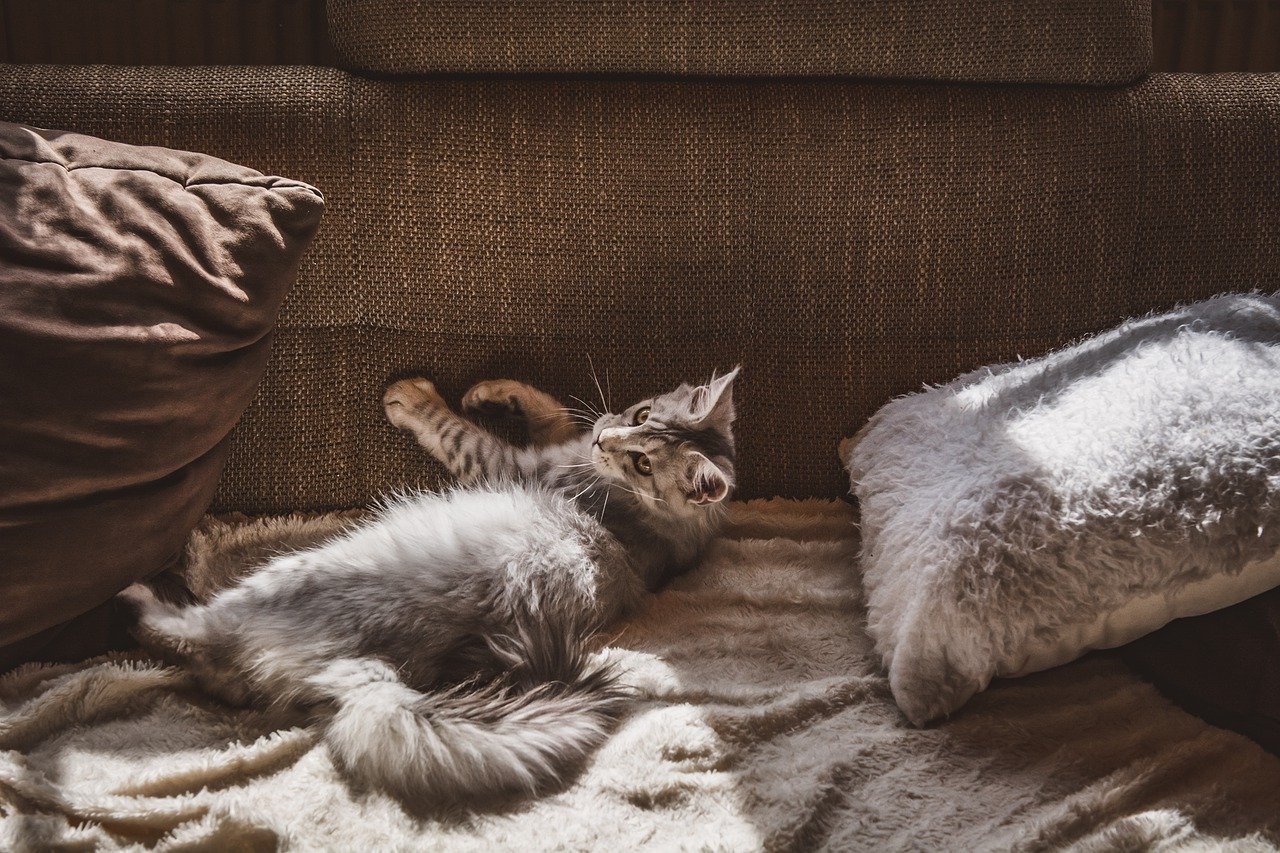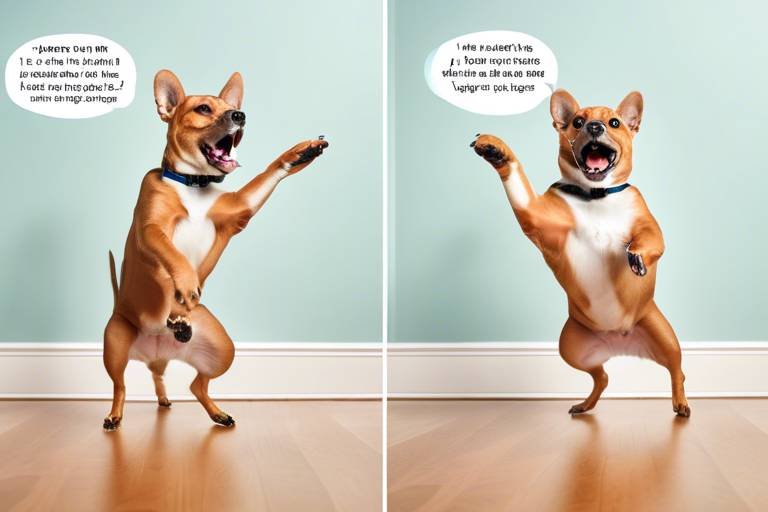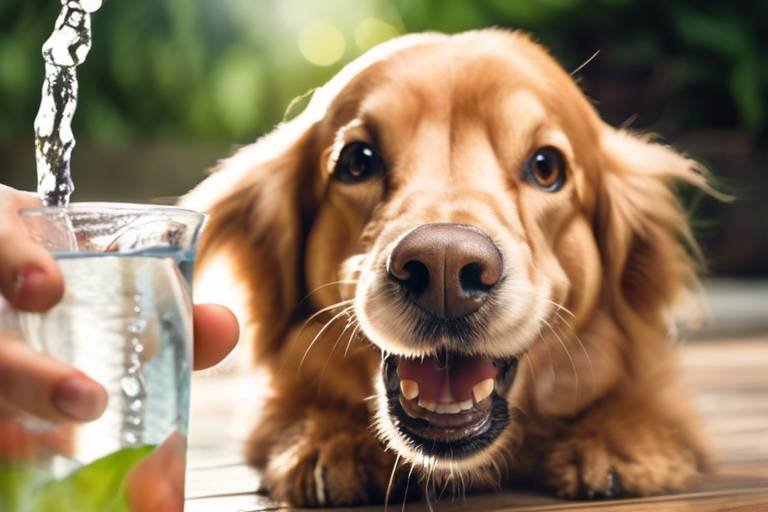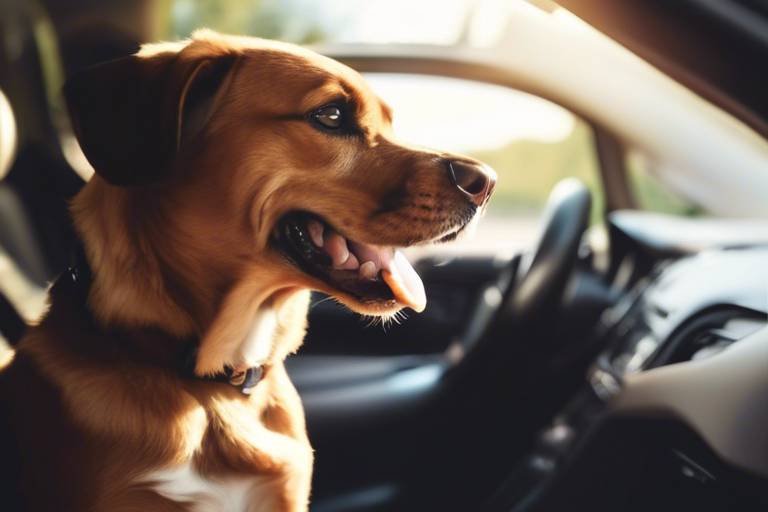How to Recognize and Treat Anxiety in Pets
As pet owners, we cherish our furry companions, and their happiness is often intertwined with our own. However, just like humans, pets can experience anxiety, which can manifest in various ways. Understanding how to recognize and treat anxiety in pets is crucial for maintaining their emotional well-being. This article will guide you through the signs of anxiety, potential causes, and effective treatment options that can help your beloved pets feel secure and happy.
Pet anxiety is not just a fleeting feeling; it can become a chronic condition if not addressed. It can arise from various factors, including environmental changes, lack of socialization, or even genetic predispositions. By understanding the nature of pet anxiety, owners can recognize symptoms early and take the necessary steps to ensure their pets feel safe and secure. Think of it as a storm brewing inside your pet; recognizing the signs early can help you calm the tempest before it wreaks havoc.
Recognizing the signs of anxiety is crucial for timely intervention. Pets may not be able to express their feelings verbally, but they communicate through their behavior. Here are some typical behaviors and symptoms that indicate a pet may be experiencing anxiety:
When pets are anxious, they may exhibit significant behavioral changes. For instance, you might notice:
- Excessive barking: This could be a cry for help or a sign of frustration.
- Destructive behavior: Chewing on furniture or scratching at doors can indicate distress.
- Withdrawal: If your pet is hiding or avoiding interaction, it may be feeling overwhelmed.
These behaviors can signal underlying emotional distress and should not be overlooked.
Physical symptoms can also provide clues about your pet's emotional state. Look for signs such as:
- Trembling: Shaking can be a clear indicator of anxiety.
- Excessive grooming: If your pet is licking or grooming itself more than usual, it may be a coping mechanism.
- Changes in appetite: A sudden decrease or increase in food intake can signal stress.
Observing these signs is essential for understanding your pet's emotional well-being.
Some situations can trigger anxiety in pets. Common triggers include:
- Loud noises, such as thunderstorms or fireworks
- Changes in the household, like moving to a new home
- New pets or family members
Identifying these triggers helps owners manage their pets' anxiety effectively. It’s like finding the source of a leak; once you know where it’s coming from, you can fix it.
Different pets may exhibit anxiety differently. For instance, dogs might bark excessively, while cats may hide under the bed. Understanding these nuances is crucial for effective treatment.
Understanding the root causes of anxiety is vital for effective treatment. Various factors contribute to anxiety in pets, including genetics and past experiences. By dissecting these causes, we can better address the issue.
Some pets may be genetically predisposed to anxiety. Certain breeds, such as Border Collies and Chihuahuas, are known to be more anxious than others. This section discusses how breed and lineage can influence a pet's susceptibility to anxiety disorders, much like how some people are more prone to anxiety due to their family history.
Environmental factors, such as changes in the household or traumatic experiences, can significantly impact a pet's mental health. For example, a pet that has experienced abandonment or abuse may develop anxiety. Identifying these factors is crucial for developing a treatment plan tailored to your pet's needs.
Fortunately, there are numerous treatment options available for managing anxiety in pets. From behavioral therapy to medication, a variety of strategies can help your furry friend cope with their emotions.
Behavioral therapy techniques can help modify an anxious pet's response to stressors. Methods such as desensitization and positive reinforcement can be particularly effective. Desensitization involves gradually exposing your pet to the source of their anxiety in a controlled manner, while positive reinforcement rewards them for calm behavior. It’s like training for a marathon; with patience and practice, your pet can learn to manage their anxiety.
For some pets, medication or supplements may be necessary to manage anxiety. Common medications include fluoxetine and sertraline, which can help regulate mood. Additionally, natural supplements like CBD oil or omega-3 fatty acids have shown promise in reducing anxiety. Always consult with your veterinarian before starting any new treatment.
Establishing a safe space for pets can significantly reduce anxiety. A calming environment promotes relaxation and security for anxious pets. Think of it as creating a cozy retreat where your pet can feel safe and secure.
Providing comfort items, such as blankets or toys, can help soothe anxious pets. Familiar objects can have a calming effect, much like a favorite childhood toy brings comfort to a child. Ensure your pet has access to these items, especially during stressful situations.
Designating a safe zone in the home allows pets to retreat when feeling overwhelmed. This could be a quiet room or a cozy corner with their favorite bed. Creating an effective safe zone involves minimizing noise and distractions, making it a sanctuary where your pet can relax and recharge.
Regularly monitoring a pet's progress is essential for effective anxiety management. Keeping track of their behavior and mood can help you evaluate treatment effectiveness and make necessary adjustments for better outcomes.
Maintaining a journal of your pet's behavior can help identify patterns and triggers. By documenting changes, you can spot trends and adjust treatment plans accordingly. It’s like being a detective, piecing together clues to understand your pet’s emotional landscape.
Consulting with veterinarians or animal behaviorists can provide valuable insights into managing pet anxiety. These professionals can offer tailored advice and treatment options based on your pet's specific needs. Remember, seeking help is a sign of strength, not weakness.
Q: Can anxiety in pets be cured?
A: While anxiety may not be completely cured, it can be effectively managed through a combination of behavioral therapy, medication, and environmental adjustments.
Q: How long does it take to see results from treatment?
A: The timeline for seeing results varies by pet and treatment method. Some may show improvement within a few weeks, while others might take longer.
Q: Are there any natural remedies for pet anxiety?
A: Yes, natural remedies such as CBD oil, chamomile, and valerian root can help soothe anxious pets. Always consult your veterinarian before trying new remedies.
Q: How can I tell if my pet is anxious?
A: Look for signs such as excessive barking, destructive behavior, trembling, or changes in appetite. If you notice these signs, it’s essential to seek help.

Understanding Pet Anxiety
Pet anxiety is a complex emotional state that can affect our furry companions in various ways. Just like humans, pets can experience feelings of stress, fear, and unease, which can manifest through different behaviors and physical symptoms. Understanding the nature of pet anxiety is crucial for pet owners who want to provide a nurturing environment for their beloved animals. By recognizing the signs of anxiety early on, owners can take proactive measures to ensure their pets feel safe and secure.
Imagine a time when you felt overwhelmed or anxious—perhaps during a thunderstorm or a big life change. Now, think about how your pet might feel in similar situations. Pets often lack the ability to communicate their feelings verbally, which makes it even more important for us to be attuned to their needs. Anxiety in pets can stem from various sources, including environmental changes, loud noises, or even separation from their owners. A thorough understanding of these factors can help us better support our pets during stressful times.
In addition to environmental stressors, it’s essential to consider how a pet's past experiences can shape their current emotional state. For instance, a rescue dog that has faced trauma may be more prone to anxiety than a pet that has been raised in a stable environment. Similarly, certain breeds may have a genetic predisposition to anxiety, making it vital for owners to be aware of their pet's lineage and any inherited traits that could contribute to their mental health.
Ultimately, the key to understanding pet anxiety lies in observing our pets closely. By being vigilant and aware of changes in behavior, we can identify when our pets are feeling anxious and take steps to help them cope. Whether it’s creating a safe space, providing comfort items, or seeking professional help, there are numerous ways to support our pets through their anxious moments. Remember, a well-understood pet is a happy pet!

Common Signs of Anxiety in Pets
Recognizing the signs of anxiety in our furry companions is crucial for timely intervention and effective treatment. Just like humans, pets can experience a range of emotions, and anxiety can manifest in various ways. It's essential to be observant and proactive to ensure that our pets lead happy, healthy lives. Some common signs of anxiety include behavioral changes, physical symptoms, and responses to specific situational triggers.
Pets often exhibit significant behavioral changes when they are feeling anxious. For instance, a normally calm dog might start barking excessively or show signs of destructive behavior, such as chewing furniture or digging at doors. Similarly, cats may become more withdrawn, hiding in corners or avoiding interaction with their owners. These changes can be alarming, but they are essential indicators of underlying emotional distress that should not be ignored.
In addition to behavioral changes, physical symptoms can also indicate anxiety in pets. You might notice your dog trembling, pacing back and forth, or even excessively grooming themselves to the point of causing skin irritations. Changes in appetite, whether it's eating less or voraciously consuming food, can also be a sign of anxiety. It's crucial to observe these signs closely as they often reflect a pet's emotional state and overall well-being.
Understanding what triggers anxiety in pets is another critical aspect of managing their emotional health. Loud noises, such as thunderstorms or fireworks, can send many pets into a frenzy. Additionally, changes in their environment, like moving to a new home or the arrival of a new family member, can also provoke anxiety. Identifying these triggers can help owners implement preventive measures and create a more secure environment for their pets.
It's important to note that different species may exhibit anxiety symptoms in unique ways. For example, while dogs might bark or whine when anxious, cats may choose to hide or become aggressive. Other household pets, like rabbits or guinea pigs, may show signs of stress through changes in grooming habits or by becoming less active. Understanding these differences is key to providing tailored support for each pet.
In summary, being vigilant about the signs of anxiety in pets—whether behavioral, physical, or situational—is essential for any pet owner. By recognizing these signs early, you can take the necessary steps to help your furry friends feel safe and secure in their environment.
- What should I do if I suspect my pet has anxiety? - It's important to consult with your veterinarian for a proper diagnosis and treatment plan.
- Can anxiety in pets be treated without medication? - Yes, many pets can benefit from behavioral therapy and environmental changes.
- How can I create a calming environment for my anxious pet? - Designate a safe space, provide comfort items, and minimize exposure to known triggers.
Behavioral Changes
When it comes to recognizing anxiety in pets, one of the most telling signs lies in their . Just like humans, our furry friends can exhibit a range of behaviors that signal they are feeling anxious or stressed. For instance, you might notice your pet barking excessively, which can be a cry for help or a way to express their unease. This sudden change in behavior can be alarming, especially if your pet is usually calm and collected.
Another common behavioral change is destructive behavior. This could manifest as chewing on furniture, scratching at doors, or even digging holes in the yard. These actions often stem from an inability to cope with their anxiety, and they might be seeking an outlet for their pent-up energy or frustration. If your dog or cat has suddenly taken to destroying your favorite shoes or clawing at the curtains, it's a clear indication that something is amiss.
Withdrawal is yet another significant behavioral change to watch for. If your pet begins to isolate themselves, avoiding interaction with family members or retreating to a corner of the house, it may be a sign that they are struggling with anxiety. Pets thrive on social interaction, and a sudden shift towards solitude can indicate that they are feeling overwhelmed. This behavior can be particularly heartbreaking for pet owners who cherish their companionship.
To better understand these behavioral changes, consider the following examples of anxiety-related actions:
- Excessive Barking: A dog that barks at every little noise or movement may be expressing anxiety.
- Destructive Chewing: Chewing on furniture or personal items can be a sign of stress or boredom.
- Hiding or Withdrawal: If your pet suddenly prefers to stay in a secluded spot, it may be feeling anxious.
It's crucial to note that these behaviors can vary significantly from one pet to another. What might be a sign of anxiety in one animal could be normal behavior for another. Therefore, it’s essential to observe your pet closely and consider their baseline behavior before jumping to conclusions. If you suspect that your pet is experiencing anxiety, it’s a good idea to consult with a veterinarian or an animal behaviorist who can help you develop a tailored approach to address these issues.
By being attentive to these behavioral changes, you can take the first steps towards helping your pet feel more comfortable and secure in their environment. Remember, just like us, pets need a little extra love and understanding when they're feeling anxious.
- What should I do if I notice my pet exhibiting signs of anxiety?
It's essential to consult with a veterinarian or an animal behaviorist to determine the best course of action tailored to your pet's specific needs. - Can anxiety in pets be treated without medication?
Yes, many pets respond well to behavioral therapy techniques, environmental modifications, and natural supplements. - How can I tell if my pet's anxiety is severe?
If your pet's anxiety leads to self-harm, extreme destructive behavior, or significant changes in eating habits, it's crucial to seek professional help.
Physical Symptoms
When it comes to our furry companions, anxiety can manifest in a variety of physical symptoms that are often overlooked. Just like humans, pets experience stress and unease, and their bodies can reflect this emotional turmoil. It's crucial for pet owners to be vigilant and recognize these signs early to provide the necessary support. Some common physical symptoms of anxiety in pets include trembling, excessive grooming, and changes in appetite.
Trembling is one of the most noticeable signs of anxiety. If your pet is shaking or quivering, it’s a clear indicator that something is amiss. This can occur in situations where they feel threatened or anxious, such as during thunderstorms or fireworks. Similarly, excessive grooming, where a pet licks or bites at their fur, can be a coping mechanism for stress. If you notice a sudden increase in grooming behavior, it may be a sign that your pet is struggling with anxiety.
Changes in appetite are also a significant indicator of anxiety. Some pets may lose their appetite completely, while others might engage in overeating as a way to cope with their emotional state. It's essential to monitor your pet's eating habits closely, as any drastic changes could signal underlying anxiety issues.
In addition to these symptoms, other physical signs may include:
- Restlessness: Constant pacing or inability to settle down can indicate anxiety.
- Vocalization: Increased barking, whining, or meowing can be a cry for help.
- Hiding: If your pet is suddenly seeking out dark, quiet places, it may be trying to escape its anxiety triggers.
Understanding these physical symptoms is crucial for pet owners. By recognizing the signs early, you can take proactive steps to help your pet feel more secure and comfortable. Remember, every pet is unique, and their anxiety may manifest differently. Keeping an eye on your furry friend's behavior can lead to early identification of anxiety and ultimately, a happier, healthier pet.
Q: How can I tell if my pet is anxious?
A: Look for signs such as trembling, excessive grooming, changes in appetite, restlessness, and vocalization. Each pet may show anxiety differently, so it's essential to observe their behavior closely.
Q: What should I do if I notice signs of anxiety in my pet?
A: Consult with your veterinarian or an animal behaviorist for guidance. They can help you create a tailored treatment plan based on your pet's specific needs.
Q: Are there natural remedies for pet anxiety?
A: Yes, there are various natural supplements and calming techniques, such as providing a safe space, using comfort items, and engaging in behavioral therapy. Always consult with a professional before starting any new treatment.
Q: Can anxiety in pets be treated with medication?
A: In some cases, medication may be necessary to help manage anxiety. Your veterinarian can recommend appropriate medications or supplements based on your pet's condition.
Situational Triggers
Understanding the that can cause anxiety in pets is crucial for effective management. Just like humans, pets can experience heightened stress levels due to specific situations or changes in their environment. These triggers can vary widely among different animals, and recognizing them is the first step in helping your furry friend feel more secure.
Common situational triggers include:
- Loud Noises: Events such as thunderstorms, fireworks, or even construction noises can send pets into a panic. Many dogs and cats have sensitive hearing, making them more susceptible to these sudden, loud sounds.
- Changes in Routine: Pets thrive on routine. Changes in your schedule, such as a new work shift or a family member moving out, can cause anxiety. Even minor adjustments, like a different feeding time, can unsettle them.
- New Environments: Moving to a new home or even a trip to the vet can be a source of stress. Pets often feel insecure when they are in unfamiliar places.
- Stranger Interactions: Whether it's a new person in the house or a visit to a busy park, unfamiliar humans or animals can trigger anxiety in pets. Some pets may be more social than others, but many prefer their familiar surroundings and companions.
By identifying these triggers, pet owners can take proactive steps to mitigate their pet's anxiety. For instance, if loud noises are a problem, consider creating a safe space where your pet can retreat during storms or fireworks. This could be a cozy corner with their favorite blanket and toys, away from windows and noise. Additionally, gradual exposure to new experiences can help desensitize your pet to potential stressors.
It's essential to observe your pet closely and note any situations that seem to provoke anxiety. Keeping a journal of these instances can help you identify patterns and develop strategies to alleviate your pet's stress. Remember, every pet is unique, and what works for one might not work for another. Tailoring your approach to your pet's specific triggers will lead to more effective anxiety management.
1. How can I tell if my pet is anxious?
Look for signs like excessive barking, destructive behavior, or physical symptoms like trembling. Changes in appetite or grooming habits can also indicate anxiety.
2. Are certain breeds more prone to anxiety?
Yes, some breeds are genetically predisposed to anxiety. For example, breeds like Border Collies and German Shepherds may exhibit higher anxiety levels compared to others.
3. What should I do if my pet experiences anxiety during thunderstorms?
Create a safe space for your pet where they can feel secure. You can also try using calming products like anxiety wraps or pheromone diffusers.
4. Can I use medication to help my anxious pet?
Yes, medication can be an option for some pets. Always consult your veterinarian to determine the best course of action for your pet's specific needs.
5. How long does it take to see improvements in my pet's anxiety?
Each pet is different, and improvements can vary. With consistent treatment and support, many pet owners notice positive changes within a few weeks to months.
Recognizing Anxiety in Different Species
When it comes to recognizing anxiety in our beloved pets, it’s essential to understand that different species exhibit their distress in unique ways. Just like humans, dogs, cats, and other pets have their own personalities, and their responses to anxiety can vary significantly. For instance, while a dog might bark excessively or chew on furniture when anxious, a cat might choose to hide away in a corner or refuse to eat. Understanding these differences not only helps in identifying anxiety but also plays a crucial role in tailoring effective treatment strategies.
Let’s break down some of the common signs of anxiety in various household pets:
| Species | Common Signs of Anxiety |
|---|---|
| Dogs |
|
| Cats |
|
| Rabbits |
|
As you can see, the signs of anxiety can be quite distinct across species. For example, dogs often display their feelings outwardly, making it easier for owners to recognize when their furry friends are feeling anxious. On the other hand, cats are more subtle; they might withdraw or become less social, which can be easily overlooked. This difference is crucial for pet owners to understand, as it ensures that they can respond appropriately to their pets' emotional needs.
Moreover, it’s important to consider that some pets may not show overt signs of anxiety. For instance, a rabbit might remain quiet but could be experiencing significant stress internally. This is where close observation and an understanding of your pet’s normal behavior come into play. If you notice any deviations from their usual demeanor, it could be a red flag indicating anxiety.
Recognizing anxiety in pets is not just about observing their behavior; it's also about understanding their environment and the factors that might contribute to their stress. For example, a dog that is normally calm may become anxious during thunderstorms or fireworks. Similarly, a cat that has recently moved to a new home may exhibit signs of anxiety as they adjust to their new surroundings.
In conclusion, being aware of how different species express anxiety is vital for any pet owner. By understanding these signs and being observant, you can help your furry friends navigate their emotional challenges and ensure they lead happy, healthy lives.
Q: How can I tell if my pet is anxious?
A: Look for changes in behavior such as excessive barking, hiding, or changes in eating habits. Each species has different signs, so observe closely.
Q: Are certain breeds more prone to anxiety?
A: Yes, some breeds, especially those that are more sensitive or have a history of trauma, may be more susceptible to anxiety.
Q: What can I do to help my anxious pet?
A: Creating a safe space, providing comfort items, and consulting with a veterinarian for treatment options can help manage anxiety.

Causes of Anxiety in Pets
Understanding the root causes of anxiety in pets is essential for effective treatment. Just like humans, pets can experience anxiety due to a variety of factors that can be both internal and external. One of the most significant contributors to anxiety in pets is their genetic predisposition. Certain breeds are more prone to anxiety disorders, which can be traced back to their lineage. For instance, breeds like Border Collies and Chihuahuas often exhibit higher levels of anxiety compared to others. This genetic factor means that some pets may have a harder time coping with stress than their peers, making it crucial for owners to recognize these traits early on.
Another major factor influencing anxiety is the environment. Pets are incredibly sensitive to changes in their surroundings, and even minor alterations can lead to significant stress. For example, moving to a new home, the arrival of a new family member, or even a change in routine can trigger anxiety. Additionally, traumatic experiences, such as abuse or abandonment, can leave lasting emotional scars on pets, making them more susceptible to anxiety. It's essential for pet owners to be observant and recognize how their pet reacts to changes, as this can provide valuable insights into their emotional state.
Moreover, the socialization experiences a pet has during its formative years play a crucial role in shaping its ability to handle stress. Pets that have not been adequately socialized may struggle with anxiety in unfamiliar situations. For instance, a dog that has not been exposed to various people, animals, and environments may become fearful or anxious when faced with new experiences. This lack of socialization can result in a cycle of anxiety, where the pet's fear leads to avoidance behaviors, further reinforcing their anxiety in similar situations.
To summarize, several key factors contribute to anxiety in pets:
- Genetic Predispositions: Certain breeds are more prone to anxiety disorders.
- Environmental Factors: Changes in the household or traumatic experiences can significantly impact mental health.
- Socialization Experiences: Lack of exposure to various stimuli during formative years can lead to heightened anxiety.
By understanding these causes, pet owners can take proactive steps to help their furry companions. This might include providing a stable environment, ensuring proper socialization, or consulting with a veterinarian for further guidance. Recognizing the underlying issues is the first step toward creating a tailored treatment plan that addresses the specific needs of each pet.
Q: What are common signs of anxiety in pets?
A: Common signs include excessive barking, destructive behavior, withdrawal, trembling, and changes in appetite. Observing these behaviors can help identify anxiety early.
Q: Can anxiety in pets be treated?
A: Yes, anxiety in pets can be managed through behavioral therapy, medication, and creating a safe environment. Consulting with a veterinarian is advisable for tailored treatment options.
Q: How can I create a safe space for my anxious pet?
A: Designate a quiet area in your home with comfort items like blankets and toys. This space should be free from loud noises and distractions, allowing your pet to retreat when feeling overwhelmed.
Q: Is anxiety in pets hereditary?
A: Yes, some pets may have a genetic predisposition to anxiety. Certain breeds are more likely to experience anxiety disorders, making it important for owners to be aware of their pet's lineage.
Q: How can I help my pet cope with anxiety during stressful situations?
A: Gradual desensitization to stressors, providing comfort items, and maintaining a calm demeanor can help your pet cope. Additionally, seeking professional advice can provide further strategies tailored to your pet's needs.
Genetic Predispositions
When it comes to understanding anxiety in pets, one of the key factors to consider is genetic predisposition. Just like humans, pets can inherit traits from their parents that influence their behavior and emotional responses. Certain breeds are more prone to anxiety than others, often due to their lineage and genetic makeup. For example, breeds like Border Collies and German Shepherds may exhibit higher levels of anxiety compared to others.
These genetic tendencies can manifest in various ways, leading to different types of anxiety disorders. For instance, a dog that is genetically predisposed to anxiety may show signs of fearfulness in new environments or react strongly to loud noises. The genetic factors at play can include a range of elements such as temperament, stress response, and even how they process fear. Understanding these predispositions can help owners anticipate and manage their pets' anxiety more effectively.
It's important to note that while genetics plays a significant role, it doesn't act alone. Environmental factors, such as early socialization and life experiences, can either exacerbate or mitigate these genetic tendencies. For example, a puppy from a breed known for anxiety may not develop anxiety issues if it receives proper socialization and positive experiences during its formative months. Conversely, a well-socialized breed with a strong genetic predisposition could still develop anxiety if faced with traumatic events.
To better understand how genetics can influence anxiety in pets, consider the following table that outlines various breeds and their associated anxiety levels:
| Breed | Common Anxiety Issues |
|---|---|
| Border Collie | Separation anxiety, noise phobias |
| German Shepherd | Fear of strangers, noise sensitivity |
| Chihuahua | Social anxiety, fearfulness |
| Labrador Retriever | Mild anxiety in stressful situations |
| Shih Tzu | Separation anxiety, fear of loud noises |
As you can see, the genetic predisposition to anxiety is a complex interplay of breed characteristics and individual temperament. Being aware of these predispositions allows pet owners to take proactive steps in managing their pets' emotional health, ensuring they lead happy and fulfilling lives.
- Can all pets develop anxiety? Yes, any pet can develop anxiety, but some breeds are more prone to it due to genetic factors.
- How can I tell if my pet is anxious? Look for signs such as excessive barking, trembling, or withdrawal. A combination of behavioral and physical symptoms often indicates anxiety.
- Is anxiety in pets treatable? Absolutely! There are various treatment options available, including behavioral therapy, medication, and environmental adjustments.
- Can genetics be changed? While genetics cannot be altered, understanding your pet's predispositions can help you create a supportive environment that minimizes anxiety triggers.
Environmental Factors
When it comes to our furry companions, the environment they live in plays a crucial role in their overall mental health. Just like humans, pets can be sensitive to changes in their surroundings. These can often trigger anxiety, making it essential for pet owners to be aware of what might be causing their pets' distress. For instance, a move to a new home, the arrival of a new family member, or even changes in the daily routine can create a sense of instability for pets. Imagine how unsettling it would be for you to suddenly find yourself in a new place with unfamiliar faces and sounds!
Several specific environmental factors can contribute to anxiety in pets:
- Noise Levels: Loud noises, such as thunderstorms, fireworks, or even construction work, can be incredibly frightening for pets. Many dogs and cats have heightened senses, making them more susceptible to sounds that humans might overlook.
- Changes in Household Dynamics: The introduction of new pets or family members can lead to feelings of jealousy or insecurity, particularly in animals that are territorial or have been the sole focus of their owner's attention.
- Inconsistent Routines: Pets thrive on routine; therefore, any disruption can lead to anxiety. For example, changes in feeding times, walk schedules, or playtime can leave them feeling uncertain about what to expect.
- Traumatic Experiences: Past traumas, such as abuse or abandonment, can leave lasting scars on pets. Even after being adopted into a loving home, these animals may still react anxiously to certain situations that remind them of their past.
Understanding these factors is vital for pet owners. By identifying what might be causing anxiety, you can take proactive steps to alleviate your pet's distress. For example, if you notice that your dog becomes anxious during thunderstorms, you might consider creating a safe space for them to retreat to, complete with their favorite blankets and toys. Additionally, maintaining a consistent daily routine can provide your pets with a sense of security, making them feel more at ease.
Remember, it’s all about creating an environment that fosters comfort and security. By being mindful of these environmental factors, you can help your pet navigate their anxiety and lead a happier, more relaxed life.
- What are common signs of anxiety in pets? Pets may show signs such as excessive barking, destructive behavior, trembling, or withdrawal from social interactions.
- Can anxiety in pets be treated? Yes, anxiety can be managed through behavioral therapy, medication, and creating a safe environment.
- How can I help my pet during loud noises? Providing a safe space with comfort items and using calming techniques can help ease their anxiety during stressful situations.
- Is it necessary to consult a veterinarian for pet anxiety? Consulting a veterinarian is advisable, especially if your pet's anxiety is severe or persistent, as they can recommend appropriate treatments.

Treatment Options for Anxious Pets
When it comes to managing anxiety in our furry companions, there’s no one-size-fits-all solution. Just like humans, pets react differently to various treatments based on their unique personalities and experiences. Fortunately, there are numerous options available that can help alleviate anxiety and promote a sense of calm. It’s essential to explore these options thoroughly and determine which combination works best for your pet.
One of the most effective approaches to treating anxiety in pets is through behavioral therapy. This method focuses on modifying a pet's response to anxiety-inducing situations. Techniques such as desensitization and positive reinforcement can be particularly beneficial. Desensitization involves gradually exposing your pet to the source of their anxiety in a controlled manner, allowing them to become accustomed to it over time. For example, if your dog is afraid of thunderstorms, you might start by playing recordings of thunder at a low volume while offering treats and praise. Over time, you can increase the volume as your pet becomes more comfortable.
In addition to behavioral therapy, some pets may require medication or supplements to help manage their anxiety. This might include prescription medications from your veterinarian or natural supplements that promote relaxation. It's crucial to consult with a veterinary professional to determine the best course of action, as they can provide guidance on the appropriate medications and dosages for your specific pet. Below is a table summarizing common medications and their uses:
| Medication | Type | Use |
|---|---|---|
| Fluoxetine | SSRI | Long-term anxiety management |
| Acepromazine | Tranquilizer | Short-term anxiety relief |
| Clomipramine | TCA | Separation anxiety treatment |
| Valerian Root | Herbal Supplement | Natural calming agent |
Creating a safe and comforting environment for your pet can also play a significant role in reducing anxiety. Establishing a designated safe space where your pet can retreat during stressful situations is vital. This area should be quiet, cozy, and filled with familiar items that provide comfort, such as blankets or favorite toys. The presence of these comfort items can help soothe an anxious pet, allowing them to feel more secure in their surroundings.
Lastly, it’s important to remember that monitoring your pet's progress and adjusting treatment as needed is crucial. Keeping a journal of your pet's behaviors and reactions can help you identify patterns and triggers, making it easier to evaluate the effectiveness of the chosen treatment plan. If you notice that certain strategies are not yielding the desired results, don’t hesitate to consult with a veterinarian or animal behaviorist. Their expertise can provide valuable insights and help you navigate the best path forward for your pet's emotional well-being.
- What are the first signs of anxiety in pets? Look for behavioral changes such as excessive barking, hiding, or destructive behavior.
- Can anxiety in pets be treated without medication? Yes, many pets respond well to behavioral therapy and environmental modifications.
- How long does it take to see improvements in anxious pets? Improvements can vary, but with consistent treatment and monitoring, many pets show progress within a few weeks.
- Is it safe to use calming supplements for pets? Always consult with your veterinarian before introducing any supplements to ensure they are safe and appropriate for your pet.
Behavioral Therapy Techniques
When it comes to helping our furry friends cope with anxiety, can be a game changer. These methods focus on changing the way pets respond to stressors, making it easier for them to navigate a world that can sometimes feel overwhelming. One of the most effective techniques is desensitization, which involves gradually exposing pets to the sources of their anxiety in a controlled manner. For instance, if your dog is afraid of thunderstorms, you might start by playing recordings of thunder at a very low volume while providing treats and praise, slowly increasing the volume as they become more comfortable.
Another powerful approach is positive reinforcement. This technique rewards pets for calm behavior, encouraging them to associate previously anxiety-inducing situations with positive outcomes. For example, if your cat tends to hide when visitors come over, you could reward them with their favorite treats when they remain calm instead of retreating. Over time, this builds their confidence and helps them learn that they can handle new situations without feeling scared.
In addition to these methods, incorporating counter-conditioning can also be beneficial. This involves changing your pet's emotional response to a trigger by pairing it with something they love. If a dog is anxious during car rides, you could start by sitting in the parked car with them, offering treats and toys, and gradually taking short trips while maintaining a positive atmosphere. The goal is to help them associate car rides with fun and safety rather than fear.
It's worth noting that while these techniques can be incredibly effective, they often require patience and consistency. Every pet is unique, and progress may vary. Therefore, it's essential to monitor their reactions closely and adjust your approach as needed. Consulting with a professional animal behaviorist can also provide tailored strategies that suit your pet's specific needs. Remember, the journey to overcoming anxiety is a marathon, not a sprint, and your support plays a crucial role in their success.
- How long does it take for behavioral therapy to work? The duration varies based on the individual pet and the severity of their anxiety. Some may show improvement within weeks, while others may take several months.
- Can I use behavioral therapy techniques on my own? Yes, many pet owners can successfully implement these techniques at home. However, professional guidance is recommended for severe cases.
- Are there any risks associated with behavioral therapy? Generally, behavioral therapy is safe. However, if a pet shows signs of increased anxiety or distress, it's important to reassess the approach or consult a professional.
Medication and Supplements
When it comes to managing anxiety in pets, sometimes behavioral strategies alone aren't enough. This is where come into play. Just like humans, pets can benefit from pharmacological interventions to help them cope with their anxiety. It's essential to consult with a veterinarian before starting any medication, as they can provide tailored recommendations based on your pet's specific needs and health conditions.
There are various types of medications that veterinarians might prescribe for anxious pets. Some of the most common include:
- Antidepressants: These can help balance mood and alleviate anxiety symptoms. Common examples include fluoxetine and sertraline.
- Anti-anxiety medications: Medications such as diazepam and alprazolam can provide immediate relief during stressful situations.
- Tranquilizers: These can be used for short-term anxiety, especially during events like thunderstorms or fireworks.
In addition to traditional medications, there are also a variety of natural supplements that pet owners can consider. These can be a great option for those looking for a more holistic approach. Some popular supplements include:
- CBD oil: Known for its calming effects, CBD oil has gained popularity among pet owners for managing anxiety.
- Melatonin: This natural hormone can help regulate sleep patterns and reduce anxiety in pets.
- Herbal remedies: Ingredients like chamomile and valerian root are often used in formulations designed to calm anxious pets.
It's important to monitor your pet's response to any medication or supplement. Some pets may experience side effects, while others may require adjustments to their dosage. Keeping an open line of communication with your veterinarian is crucial for finding the right balance and ensuring your furry friend feels their best.
In conclusion, while medication and supplements can be effective tools in managing pet anxiety, they should be used in conjunction with behavioral therapies and environmental modifications. By taking a comprehensive approach, you can help your pet navigate their anxiety and lead a happier, more relaxed life.
Q: How do I know if my pet needs medication for anxiety?
A: If your pet exhibits severe anxiety symptoms that interfere with their daily life, such as excessive barking, destructive behavior, or withdrawal, it's time to consult with your veterinarian.
Q: Are there any side effects to pet anxiety medications?
A: Yes, like any medication, there can be side effects. Common side effects may include lethargy, changes in appetite, or gastrointestinal issues. Always monitor your pet closely and report any concerning symptoms to your vet.
Q: Can I use human medications for my pet?
A: No, you should never give human medications to pets without consulting a veterinarian. Some human medications can be toxic to animals, so it's crucial to use only vet-approved products.
Q: How long does it take for anxiety medication to work?
A: The time frame can vary depending on the type of medication and the individual pet. Some medications may take a few days to show effects, while others might work more quickly.

Creating a Safe Space
Establishing a safe space for your pets is one of the most effective ways to help them cope with anxiety. Just like we need a cozy corner to unwind after a long day, pets also crave a sanctuary where they can feel secure and relaxed. A safe space acts as a refuge, a place where they can retreat when the world feels overwhelming. It’s essential to create an environment that promotes calmness and security, tailored to your pet's specific needs.
When designing this safe haven, consider the following elements:
- Location: Choose a quiet area in your home, away from the hustle and bustle. This could be a cozy corner in the living room or a secluded spot in a bedroom.
- Comfort: Use soft bedding, such as a plush blanket or a favorite pillow, to make the space inviting. Pets often feel more at ease when they have a comfortable spot to curl up in.
- Familiar Items: Incorporate items that smell like you or that your pet loves, such as toys or blankets. These familiar scents can provide a sense of security and comfort.
Moreover, consider adding a few of your pet's favorite toys or chew items to keep them entertained while they relax. It's like creating a mini retreat for them, where they can unwind and feel at peace.
Another critical aspect of a safe space is ensuring it is free from any potential stressors. For example, if your pet is frightened by loud noises, like thunder or fireworks, try to position their safe zone in a part of the house that is insulated from these disturbances. You might also consider using soundproofing materials or white noise machines to help drown out any jarring sounds.
Lastly, it's vital to respect your pet's space. When they retreat to their safe zone, it’s important to give them the privacy they need. Just as we wouldn't want someone to invade our personal space when we’re feeling anxious, pets also need that time to decompress without interruption. This respect can help them feel more secure and understood.
In summary, creating a safe space for your pet is not just about providing a physical location; it’s about fostering an environment that nurtures their emotional well-being. By focusing on comfort, familiarity, and respect, you can help your furry friend navigate their anxiety more effectively.
Here are some common questions pet owners have about creating a safe space for their anxious pets:
- How do I know if my pet needs a safe space? Look for signs of anxiety such as excessive barking, hiding, or destructive behavior. If your pet seems overwhelmed, it may be time to create a safe space.
- Can I use a crate as a safe space? Yes, many pets find crates comforting, as they mimic a den-like environment. Ensure it’s well-padded and filled with familiar items.
- What if my pet doesn't use the safe space? Encourage them gently by placing treats or toys inside. Make it a positive experience without forcing them.
Comfort Items
When it comes to easing anxiety in our beloved pets, play a crucial role. Just like how a favorite blanket or a cherished toy can provide solace to a child, pets too find comfort in familiar objects. These items not only help to soothe their nerves but also create a sense of security in an otherwise chaotic world. Imagine how a soft, plush toy can turn a stressful moment into a cozy retreat for your furry friend. It's all about creating that safe haven where they can feel at ease.
Comfort items can come in various forms, and it's essential to choose the right ones that resonate with your pet. For example, a favorite blanket can carry the scent of home, making it a perfect companion during times of stress. Additionally, many pets find solace in chew toys or interactive toys that not only distract them but also engage their minds. These items can serve as a great outlet for pent-up energy and anxiety, allowing them to channel their stress into play.
Here are some examples of comfort items that can help alleviate anxiety in pets:
- Blankets: A soft, familiar blanket can provide warmth and a sense of security.
- Toys: Chew toys or plush toys that are favored by your pet can distract them from anxiety triggers.
- Clothing: An article of clothing that smells like you can be incredibly comforting.
- Calming beds: Beds designed to provide a snug and secure feeling can help anxious pets relax.
It's also important to rotate these items regularly to keep their interest piqued. Just like us, pets can get bored with the same old toys and blankets. By introducing new comfort items or rotating existing ones, you can keep their environment stimulating and engaging. Remember, the goal is to create a space where your pet can retreat and feel safe, especially during stressful situations like thunderstorms or fireworks.
In addition to physical comfort items, consider incorporating calming scents into your pet's space. Products infused with lavender or chamomile can have a soothing effect, further enhancing the calming environment you've created. Just as a warm cup of tea can relax us after a long day, these scents can help your pet unwind and feel more at home.
Ultimately, the right comfort items can make a world of difference in managing your pet's anxiety. By being attentive to their needs and preferences, you can provide them with a sense of security and peace. After all, our pets rely on us to create a nurturing environment, and with a little effort, we can help them navigate their emotional challenges with grace.
Q1: What are some signs that my pet is anxious?
A1: Common signs of anxiety in pets include excessive barking, destructive behavior, trembling, excessive grooming, and changes in appetite. If you notice any of these behaviors, it may be time to assess your pet's emotional well-being.
Q2: Can comfort items really help with my pet's anxiety?
A2: Yes! Comfort items can provide a sense of security and familiarity, helping to soothe anxious pets. Items like blankets and toys can create a safe space for them to retreat to during stressful situations.
Q3: How do I choose the right comfort items for my pet?
A3: Observe your pet's preferences. Do they have a favorite toy or blanket? Try introducing a variety of comfort items and see which ones they gravitate towards. It's all about what makes them feel safe and secure.
Q4: Are there any scents that can help calm my pet?
A4: Yes, scents like lavender and chamomile are known for their calming properties. You can find pet-safe calming sprays or diffusers that incorporate these scents to help create a soothing environment.
Safe Zones
Creating a safe zone in your home is one of the most effective ways to help your furry friend cope with anxiety. Think of it as a cozy retreat where your pet can feel completely secure, much like how we all need a little corner of comfort during stressful times. This space should be a designated area that your pet can access whenever they feel overwhelmed or anxious. It’s essential to choose a quiet spot in your home, away from the hustle and bustle, where your pet can unwind without disturbances.
When setting up a safe zone, consider incorporating items that provide comfort and familiarity. For instance, adding your pet's favorite blanket or a few of their beloved toys can create a sense of security. These familiar objects serve as anchors, reminding your pet that they are in a safe place. Additionally, you might want to use a pet bed that is soft and inviting, allowing your pet to snuggle in and feel protected. The key is to make this space as inviting as possible, as it will become their sanctuary during stressful moments.
Another important aspect of a safe zone is ensuring it is free from loud noises and sudden movements. If your pet is particularly sensitive to sounds, consider soundproofing the area with soft materials or even using a white noise machine to drown out any jarring noises from outside. Furthermore, you can create a cozy ambiance with low lighting or a calming scent, such as lavender, which can help promote relaxation.
Don’t forget to train your pet to recognize this safe zone. Encourage them to go there when they feel anxious by rewarding them with treats or praise when they use it. Over time, your pet will associate this area with comfort and safety, making it a go-to spot during stressful situations. Remember, the objective is to empower your pet to seek refuge in their safe zone whenever they need it, fostering a sense of independence and control over their anxiety.
In summary, establishing a safe zone is a crucial step in managing your pet's anxiety. By creating a comfortable and secure environment, you are not only helping your pet cope with their fears but also enhancing their overall emotional well-being. It’s a simple yet powerful way to show your furry friend that they have a place to go when the world feels overwhelming.
- What should I include in my pet's safe zone? Include items such as a comfortable bed, familiar toys, and blankets, along with a quiet environment.
- How do I know if my pet is using the safe zone? Look for signs such as your pet going there on their own during stressful times or spending more time in that area when feeling anxious.
- Can I use the safe zone for training purposes? Yes, you can use treats and positive reinforcement to encourage your pet to associate the safe zone with comfort and security.
- How long does it take for a pet to adapt to the safe zone? Each pet is different, but with consistent encouragement, many pets will begin to use their safe zone within a few weeks.

Monitoring Progress and Adjusting Treatment
When it comes to managing anxiety in pets, monitoring progress is crucial. Just like humans, pets can have good days and bad days, and keeping an eye on their behavior can help you identify what works and what doesn’t. Are they more relaxed after a certain treatment or technique? Are there specific triggers that seem to cause more anxiety on some days? By observing these patterns, you can make informed decisions about their care.
One effective way to monitor your pet's progress is by maintaining a behavior journal. This journal can include notes on your pet’s daily behavior, any anxiety triggers you notice, and the effectiveness of different treatments. For example, you might document how your dog reacts to thunderstorms or how your cat behaves when strangers visit. Over time, this record can reveal trends that help you understand your pet's anxiety better.
In addition to journaling, it’s essential to consult with professionals regularly. Veterinarians and animal behaviorists can provide valuable insights and may suggest adjustments to your pet's treatment plan based on their observations. They can help you determine whether a medication is effective or if a different approach might yield better results. Regular check-ins with a professional ensure that you’re not only addressing the symptoms of anxiety but also the underlying causes.
Another key aspect of monitoring progress is being aware of your pet's body language. Subtle shifts in their demeanor can indicate whether they are feeling better or if their anxiety is worsening. For instance, a previously social dog that starts to hide or a cat that becomes more vocal may need a reassessment of their treatment plan. Understanding these signs can make a world of difference in how you approach their care.
Lastly, it’s important to remain patient and flexible. Adjusting treatment is not always a quick fix, and it may take time to find the right combination of therapies. Just like a puzzle, sometimes you have to try a few pieces before everything fits perfectly. Remember that your furry friend relies on you for support and guidance, so staying observant and proactive will help them feel more secure in their environment.
- How long does it take to see improvements in my pet's anxiety?
Improvements can vary based on the individual pet and the treatment approach. Some may show changes within weeks, while others might take months. - Should I consult a veterinarian before starting any treatment?
Yes, it’s always best to consult with a veterinarian to ensure the chosen treatment is safe and appropriate for your pet. - Can I use natural remedies for my pet’s anxiety?
Natural remedies can be effective for some pets, but it’s important to discuss these options with your vet to avoid any adverse effects.
Keeping a Journal
Keeping a journal for your pet is like having a personal diary that unlocks the hidden emotions and behaviors of your furry friend. This practice can be incredibly insightful, as it allows you to track patterns and identify triggers that may contribute to your pet's anxiety. Just imagine having a roadmap that guides you through your pet's emotional landscape! By noting down daily observations, you can spot trends over time, such as when your pet seems most anxious or what specific events lead to a spike in their stress levels.
To get started, consider creating a structured format for your journal. You might want to include sections such as:
- Date: Always note the date to track changes over time.
- Behavior Observed: Describe any anxious behaviors, such as barking, hiding, or excessive grooming.
- Situational Context: Record what was happening around your pet during these behaviors. Were there loud noises? New visitors? Changes in the household?
- Duration: How long did the anxious behavior last? Was it a brief moment or an extended period?
- Response to Treatment: If you’ve implemented any strategies or treatments, note how your pet reacted to them.
By keeping all this information in one place, you create a comprehensive picture of your pet’s anxiety. This journal can serve as a vital communication tool when discussing your pet's issues with veterinarians or animal behaviorists. They can provide more tailored advice based on the detailed observations you’ve gathered. Plus, reviewing your journal can be a great way to celebrate small victories! Did your pet seem less anxious during a thunderstorm after using a calming supplement? Write it down! These little wins are important for both you and your pet.
In essence, maintaining a pet journal is not just about documenting behaviors; it’s about fostering a deeper connection with your pet. It encourages you to be more observant and engaged, which can lead to better understanding and ultimately a happier, healthier pet. So grab a notebook or open a notes app on your phone, and start your journey towards understanding your furry companion better!
Q: What should I include in my pet journal?
A: Include the date, observed behaviors, situational context, duration of anxiety, and responses to any treatments.
Q: How often should I update the journal?
A: Aim to update it daily or whenever you notice significant behaviors or changes in your pet's anxiety levels.
Q: Can a journal really help with my pet's anxiety?
A: Yes! It provides valuable insights that can help you and your veterinarian develop a more effective treatment plan.
Q: What if I don’t notice any patterns?
A: Even if you don’t see clear patterns, documenting behaviors can still help you communicate effectively with professionals who can assist you.
Consulting with Professionals
When it comes to managing anxiety in pets, sometimes the best course of action is to seek the expertise of professionals. Just like humans, pets can greatly benefit from the insights and guidance provided by veterinarians and animal behaviorists. These professionals have the knowledge and experience to assess your pet's specific situation and recommend tailored treatment plans that can lead to significant improvements in their emotional well-being.
Consulting a veterinarian is crucial, especially if you notice persistent signs of anxiety in your furry friend. A vet can evaluate your pet's health, rule out any underlying medical conditions that might be contributing to their anxiety, and discuss appropriate treatment options. This could include behavioral therapies, medications, or a combination of both. It's essential to have a clear understanding of your pet's unique needs, and a veterinarian can help you navigate the myriad of options available.
Additionally, animal behaviorists specialize in understanding the behavioral patterns of pets. They can observe your pet's behavior in various situations and identify triggers that might lead to anxiety. By employing techniques such as desensitization and counter-conditioning, these professionals can help modify your pet's response to stressors, making them feel more secure in their environment.
Here are some key points to consider when consulting with professionals:
- Be Prepared: Before your appointment, take notes on your pet's behavior, including specific incidents of anxiety, duration, and frequency. This information will be invaluable for the professional.
- Ask Questions: Don’t hesitate to ask about the recommended treatments, potential side effects, and what to expect during the process. Understanding the plan will help you feel more confident in managing your pet's anxiety.
- Follow-Up: Regular follow-ups are important to monitor your pet’s progress. Adjustments may be necessary based on how your pet responds to the initial treatment.
In conclusion, consulting with professionals not only provides you with a roadmap for managing your pet's anxiety but also reassures you that you are taking the right steps toward improving their quality of life. Remember, addressing anxiety is a journey, and having the right support can make all the difference.
Q1: How do I know if my pet needs professional help for anxiety?
If your pet exhibits persistent signs of anxiety, such as excessive barking, destructive behavior, or withdrawal, it may be time to consult a professional. Observing these behaviors over a period of time can help you determine if intervention is necessary.
Q2: Can anxiety in pets be treated without medication?
Yes, many pets can benefit from behavioral therapy techniques and environmental adjustments without the need for medication. However, in some cases, medication may be necessary to help manage severe anxiety.
Q3: How long does it take to see improvements in my pet's anxiety?
The time it takes to see improvements can vary greatly depending on the individual pet and the treatment plan. Some pets may show improvement within a few weeks, while others may take several months. Regular monitoring and adjustments to the treatment plan can help speed up the process.
Frequently Asked Questions
- What are the common signs of anxiety in pets?
Common signs of anxiety in pets include excessive barking, destructive behavior, trembling, withdrawal, and changes in appetite. If you notice any of these behaviors, it’s important to pay attention to your pet’s emotional state.
- What causes anxiety in pets?
Anxiety in pets can be caused by a variety of factors, including genetic predispositions, environmental changes, traumatic experiences, and even certain situations like loud noises. Understanding these causes can help you address your pet's anxiety more effectively.
- How can I help my anxious pet?
There are several ways to help an anxious pet, including creating a safe space, providing comfort items, and using behavioral therapy techniques. In some cases, medication or supplements may also be necessary, so consulting with a veterinarian is a good idea.
- What is a safe space for my pet?
A safe space is a designated area in your home where your pet can retreat when feeling anxious. This area should be quiet, comfortable, and filled with familiar items like blankets or toys to help your pet feel secure.
- How can I monitor my pet's progress?
Keeping a journal of your pet’s behavior can be incredibly helpful in monitoring progress. By noting patterns and triggers, you can better understand what works and what doesn’t in managing their anxiety.
- When should I consult a professional about my pet's anxiety?
If your pet's anxiety persists despite your efforts, or if their behavior becomes increasingly concerning, it’s time to consult with a veterinarian or an animal behaviorist. Professional guidance can provide valuable insights and tailored treatment options.



















